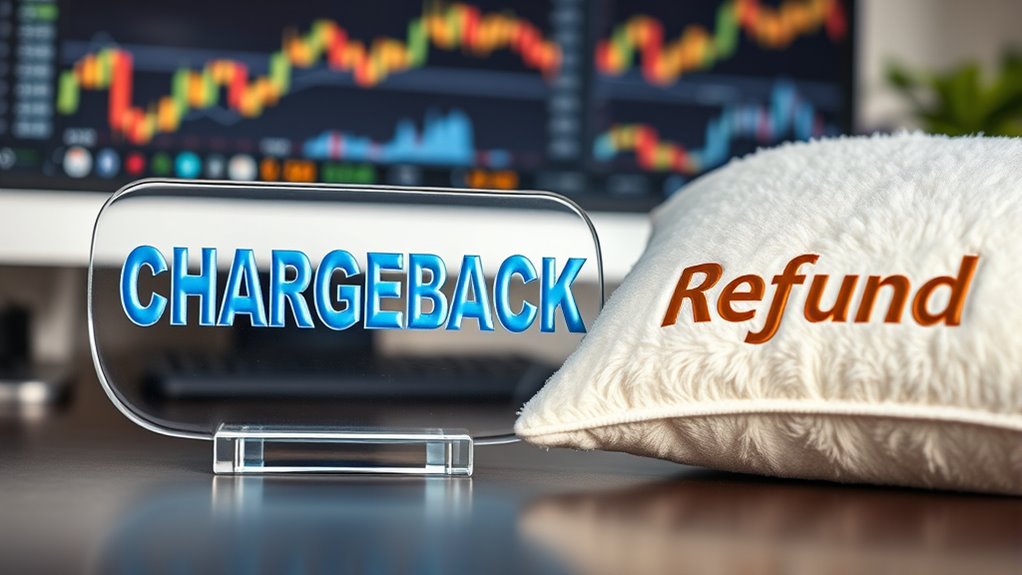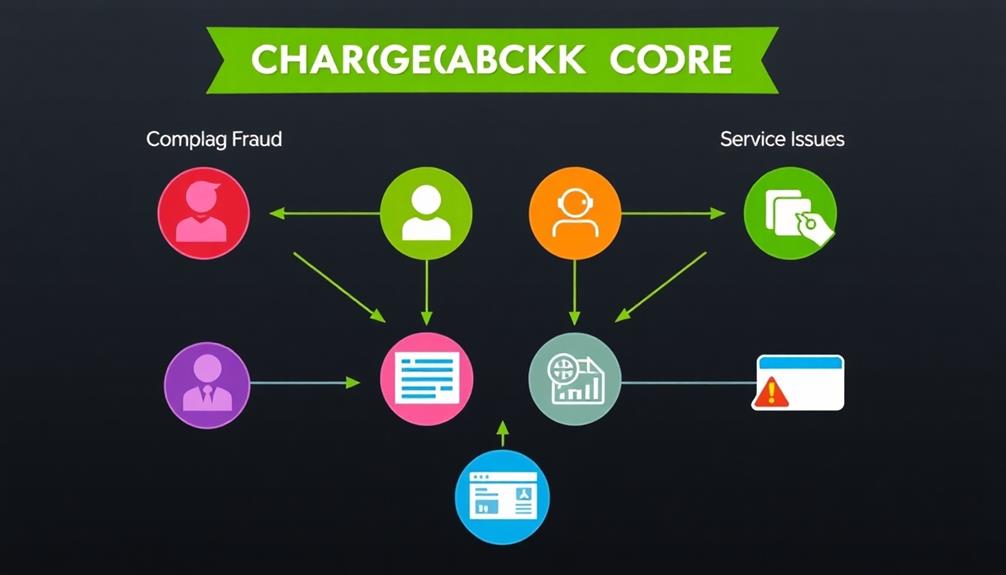A refund is initiated by you, the merchant, when a customer requests their money back due to dissatisfaction, product issues, or service problems. A chargeback, however, occurs when the customer disputes a transaction through their bank or credit card issuer, often due to fraud or unauthorized charges. Refunds are straightforward and controlled by you, while chargebacks involve external decisions and can impact your revenue and reputation. To learn more about managing these processes effectively, keep exploring.
Key Takeaways
- Refunds are initiated by merchants to return money when customers are dissatisfied or products are defective; chargebacks are initiated by customers’ banks due to disputes.
- Refunds are controlled directly by merchants, while chargebacks involve external bank decisions and require merchant response within set timeframes.
- Refunds typically cost merchants directly and are simpler; chargebacks can lead to financial losses, fees, and damage to reputation if lost.
- Use refunds to resolve genuine customer issues quickly; initiate chargebacks only when fraud or unauthorized transactions are suspected.
- Prevent chargebacks through clear records and good customer service; issue refunds promptly to maintain customer trust and satisfaction.

A refund is a straightforward process you initiate when a customer requests their money back, usually because of dissatisfaction, a product defect, or a service issue. As a merchant, you control when and how refunds happen, often following your store policies. When you issue a refund, you return the funds directly to the customer, and the transaction is settled without involving the card issuer or payment processor beyond the initial authorization. This process typically isn’t controversial, and there’s little to no dispute involved. It’s a simple way to resolve customer complaints and maintain trust. Additionally, refunds can be managed efficiently through efficient general ledger coding, helping ensure all transactions are accurately recorded and reported.
In contrast, a chargeback is a more complex and adversarial process initiated by the customer through their bank or credit card issuer. If a customer disputes a charge — claiming fraud, an unauthorized transaction, or a service/product issue — their bank may decide to reverse the payment, pulling funds from your merchant account. This is where merchant liability comes into play. When a chargeback occurs, you’re often responsible for providing evidence that the transaction was legitimate, fulfilled correctly, and authorized by the customer. The dispute process then begins, where you need to respond within specific timeframes to defend your case. If you lose the dispute, the funds are refunded to the customer, and you may also face additional penalties or fees from your payment processor.
The key difference lies in control and risk. With refunds, you’re in charge; you decide when to issue one and bear the cost directly. With chargebacks, the process is initiated externally, and you risk losing revenue, paying chargeback fees, and potentially harming your merchant reputation. To minimize chargebacks, it’s essential to have clear transaction records, excellent customer service, and prompt responses during the dispute process. Being proactive can help you manage disputes effectively and reduce the financial impact.
Frequently Asked Questions
Can a Chargeback Be Reversed Once Initiated?
Yes, a chargeback can be reversed once initiated, but it depends on the dispute resolution process. You should submit evidence to the card issuer to support your case and request a chargeback reversal. If your evidence is convincing, the issuer may overturn the chargeback. Keep in mind, timely communication and proper documentation are essential during dispute resolution to increase your chances of reversing the chargeback successfully.
What Are Common Reasons for a Chargeback Dispute?
You often face chargeback disputes due to reasons like unauthorized transactions, product not received, or billing errors. Customers may dispute charges during dispute resolution if they suspect fraud or feel they didn’t get what they paid for. To prevent these issues, you should implement strong fraud prevention measures and clear communication. Address disputes promptly, providing proof of delivery or transaction details, to help resolve the issue efficiently and protect your business.
How Long Does a Refund Typically Take to Process?
Did you know that 70% of refunds are processed within three to five business days? Typically, processing time for refunds varies depending on your payment method and bank, but most take around this timeframe. Refund delays can happen due to bank processing times or holiday weekends. To avoid frustration, keep your customers informed about potential processing times, and always check with your payment provider for specific timelines.
Are There Fees Associated With Issuing Refunds?
Yes, there can be fees associated with issuing refunds, depending on your refund policy and the payment processor. Some companies charge processing fees or a percentage of the refund amount, which you should consider when setting your policies. Make sure your refund policy clearly states if any fees apply so customers know in advance, and be aware that these fees can impact your overall costs when issuing refunds.
How Do Chargebacks Impact Merchant Accounts?
Oh, the joy of chargebacks—your favorite way to turn dispute resolution into a nightmare. They hit your merchant account hard, increasing liability and risking higher fees. When a customer disputes a transaction, you’re on the hook for the refund, plus potential penalties. This process can drain your resources, damage your reputation, and make you think twice before accepting chargebacks. Basically, they turn your smooth operation into chaos.
Conclusion
So, next time you’re quick to process a refund or let a chargeback slide, remember—they’re just different paths to the same destination: customer satisfaction… or chaos. Ironically, what seems like a simple fix can sometimes turn into a costly mess. Whether you choose to resolve issues directly or let the bank decide, the real lesson is that understanding these tools helps you avoid surprises—because in the end, it’s your business that pays the price.









